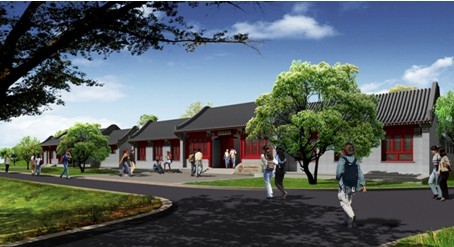Peking University, May 9, 2012: Stanford is sharpening its academic focus on one of the world's fastest growing nations by establishing a prominent presence at China's Peking University. Slated to open in early 2012, the Stanford Center at Peking University (SCPKU) will serve as a headquarters for Stanford students and faculty conducting research in China.

The building's design gracefully combines
the best of Chinese and western architecture, as depicted in this artistic rendering

Construction began in summer of 2010 for the new Stanford Center at Peking University
Coit Blacker, director of the Freeman Spogli Institute for International Studies, will make a presentation about the center to members of the Faculty Senate today.
Designed as a resource for the entire Stanford community, seven well-established programs and departments – including the School of Medicine's Asian Liver Center, the Bing Overseas Studies Program and the Center for Sustainable Development and Global Competitiveness – already have committed to locating operations on the Beijing campus.
"China's position as a global economic leader means that the university should be at the forefront of helping our students and faculty better understand the country's policies, culture and views while at the same time forging intellectual ties with its brightest and most important thinkers," said Stanford President John Hennessy.
"Peking University is an ideal place to forge this partnership. The new Stanford Center will foster this exchange of ideas and help facilitate new research partnerships, as well as provide our students with the firsthand opportunities that prepare them to become global citizens," Hennessy added.
The new facility will allow Stanford researchers currently working from bases around China to come together under one roof. It also will offer the opportunity for Stanford faculty to collaborate, share ideas and teach classes with faculty from Peking University and other universities throughout China. Construction began last summer.
"Peking University prides itself as one of the most open and academically free places in China," said Scott Rozelle, director of Stanford's Rural Education Action Project, which focuses on bridging the educational gap between rural and urban Chinese children. The project will be housed at SCPKU.
"Having a venue like this will definitely play an important role in bringing people together and focusing research projects in China," said Rozelle, who spends up to six months a year in China developing and analyzing programs to improve nutrition, education and health care in some of the country's poorest regions.
The Stanford Center will be built next to the National Institute for Mathematics Research, the China Center for Economic Research, the Center for Research on Ancient Chinese History and the Institute for Chinese Painting. The traditional Chinese siheyuan building will surround a private courtyard. Beneath the ground floor, a state-of-the-art facility two stories deep will feature modern classrooms, offices and conference spaces.
"Right now, we're always having to meet people in hotel rooms and restaurants in China," said Barbara Ralston, vice president for Stanford Hospital's International Medical Services, which coordinates medical care for Stanford affiliates and Silicon Valley residents traveling overseas, as well as international patients at Stanford Hospital. The program, which will occupy space at SCPKU, also supports medical school faculty doing international work and sponsors several events in China.
"This new building gives us a wonderful opportunity to have a home base in China. It really enhances our ambassadorship," Ralston said.
Stanford's School of Engineering currently runs internship, visiting research and exchange programs at Peking University. And the new facility will allow the schools to deepen their mutual commitment to teaching and shaping the world's top engineers.
"We want to recruit the best and brightest students from China," said Pamela Hinds, faculty director for the engineering school's programs in China. "The new center will promote Stanford's prominence in China. It's an important effort to increase our reputation and increase our ability to attract the top engineering students."
Gi-Wook Shin, director of the Shorenstein Asia-Pacific Research Center, said SCPKU will make it easier to engage a greater number of Asian professors and researchers.
"It's more convenient for Asians to come to a place in China than to come to California for a conference or seminar that we host," Shin said. "It's important for Stanford to have a strong presence in China so we can engage Asian people on Asian issues."
Stanford's relationship with China stretches back to the late 1970s, when the university began accepting Chinese graduate students. Students from China have accounted for the largest number of Stanford's foreign graduate students for the past decade, with 575 enrolled this year.
Over the last 30 years, Stanford's relationship with Peking University also has grown from an initial collaboration between the schools' Asian language departments to a wide range of joint research and academic exchanges. In 2004, Stanford's study abroad and internship programs began at Peking University. They are now managed by the Bing Overseas Studies Program, which hosts roughly 70 undergraduates every year on the Peking University campus.
The bond between the schools was strengthened in 2006 when Stanford political scientist Jean Oi and sociologist Andrew Walder envisioned a way to bolster Stanford research, teaching, training and outreach activities in China. Their ideas led to the creation of SCPKU and several new academic programs, including a law school exchange program.
"When it becomes an active research center, the facility will add a host of opportunities for our students and the PKU students who are auditing our courses," said Robert Sinclair, director of the Bing Overseas Studies Program.
The $5 million project is funded entirely from gifts made to the Stanford International Initiative.
For Chien Lee, a Hong Kong-based private investor whose family's charitable foundation is the lead donor, the link between Stanford and Peking University is personal.
The SCPKU building will be named for his father, the late Lee Jung Sen, who attended Peking University in the mid-1930s when it was Yenching University. Lee's mother, Leatrice Lowe Lee, graduated from Stanford in 1945.
"It will be a good partnership," said Lee, who received his bachelor's, master's and business degrees from Stanford in the 1970s and is a former Stanford trustee. "When you get great people together, you can really achieve something."
Written by: Adam Gorlick
Edited by: Yan Binghan
Source: Stanford Report